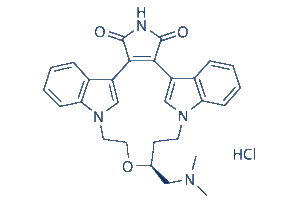Ruboxistaurin hydrochloride (LY333531)
This product is for research use only, not for human use. We do not sell to patients.

For small sizes, please check our retail website as below: www.invivochem.com
| Size | Price | Stock |
|---|---|---|
| 250mg | $1550 | To Be Confirmed |
| 500mg | $2350 | To Be Confirmed |
| 1g | $3525 | To Be Confirmed |
Cat #: V2574 CAS #: 169939-93-9 Purity ≥ 98%
Description: Ruboxistaurin HCl, the hydrochloride salt of Ruboxistaurin (LY-333531; LY333531), is a novel, potent and specific inhibitor of PKCβ (protein kinase C) with diabetic effects.
Top Publications Citing Invivochem Products
Publications Citing InvivoChem Products
Product Promise

- Physicochemical and Storage Information
- Protocol
- Related Biological Data
- Stock Solution Preparation
- Quality Control Documentation
| Molecular Weight (MW) | 505.01 |
|---|---|
| Molecular Formula | C28H28N4O3.HCl |
| CAS No. | 169939-93-9 |
| Storage | -20℃ for 3 years in powder formr |
| -80℃ for 2 years in solvent | |
| Solubility In Vitro | DMSO: 50 mg/mL (99.0 mM)r |
| Water: <1 mg/mLr | |
| Ethanol: <1 mg/mL | |
| SMILES Code | O=C1NC(C2=C1C3=CN(C4=CC=CC=C34)CC[C@@H](CN(C)C)OCCN5C=C2C6=CC=CC=C56)=O.[H]Cl |
| Synonyms | Ruboxistaurin, LY333531; LY-333531 hydrochloride; LY 333531 hydrochloride |
| Protocol | In Vitro | Ruboxistaurin hydrochloride is a selective and ATP-competitive PKCβ inhibitor, with IC50s of 4.7 and 5.9 nM for PKCβI and PKCβII, shows less potent inhibition on PKCη (IC50, 52 nM), PKCα (IC50, 360 nM), PKCγ (IC50, 300 nM), PKCδ (IC50, 250 nM), and has no effect on PKCζ (IC50, >100 μM). |
|---|---|---|
| In Vivo | Ruboxistaurin (1 mg/kg; 8 weeks) markedly reduces GEC apoptosis as well as swiprosin-1 upregulation, and ameliorates renal glomerular injury in the diabetic mice. Ruboxistaurin also potently attenuates the expression of PARP, cleaved-caspase9, cleaved-caspase3, and the Bax/Bcl-2 ratio, in diabetic mice. |
These protocols are for reference only. InvivoChem does not
independently validate these methods.
| Solvent volume to be added | Mass (the weight of a compound) | |||
|---|---|---|---|---|
| Mother liquor concentration | 1mg | 5mg | 10mg | 20mg |
| 1mM | 1.9802 mL | 9.9008 mL | 19.8016 mL | 39.6032 mL |
| 5mM | 0.3960 mL | 1.9802 mL | 3.9603 mL | 7.9206 mL |
| 10mM | 0.1980 mL | 0.9901 mL | 1.9802 mL | 3.9603 mL |
| 20mM | 0.0990 mL | 0.4950 mL | 0.9901 mL | 1.9802 mL |
The molarity calculator equation
Mass(g) = Concentration(mol/L) × Volume(L) × Molecular Weight(g/mol)
Mass
=
Concentration
×
Volume
×
Molecular Weight*
The dilution calculator equation
Concentration(start)
×
Volume(start)
=
Concentration(final)
×
Volume(final)
This equation is commonly abbreviated as: C1 V1 = C2 V2
Concentration(start)
C1
×
Volume(start)
V1
=
Concentration(final)
C2
×
Volume(final)
V2
Step One: Enter information below
Dosage mg/kg
Average weight of animals g
Dosing volume per animal µL
Number of animals
Step Two: Enter the in vivo formulation
%DMSO
+
%
+
%Tween 80
+
%ddH2O
Calculation Results:
Working concentration:
mg/ml;
Method for preparing DMSO master liquid:
mg
drug pre-dissolved in
µL
DMSO(Master liquid concentration
mg/mL)
,Please contact us first if the concentration exceeds the DMSO solubility of the batch of drug.
Method for preparing in vivo formulation:
Take
µL
DMSO master liquid, next add
µL
PEG300, mix and clarify, next add
µL
Tween 80,mix and clarify, next add
µL
ddH2O,mix and clarify.
Note:
- (1) Please be sure that the solution is clear before the addition of next solvent. Dissolution methods like vortex, ultrasound or warming and heat may be used to aid dissolving.
- (2) Be sure to add the solvent(s) in order.




































